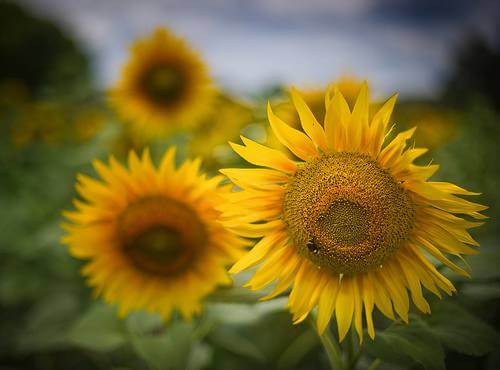
Discovered during the 19th century, photosynthesis is a process by which plants convert electromagnetic waves into chemical energy, which supports plant growth and regeneration. By harnessing solar power, plants use photosynthesis to produce energy stores that are harvested in the food chain. Plant-based sweeteners, such as glucose and fructose, are sugars formed from byproducts of photosynthesis. Carbohydrate byproducts of photosynthesis also provide an important fuel source for renewable energy production. In addition, photosynthesis is essential for flower formation in plants. For example, cellulose fibers give plant stems rigidity and provide a support structure for flower buds. Plants produce cellulose from carbohydrate byproducts of photosynthesis using chemical energy generated during this process.
The Process
Light triggers photosynthesis in plants. Electromagnetic waves, such as light, are composed of photons: massless particles of electromagnetic energy. Photons travel through the transparent outer layers of a plant and are absorbed by antenna proteins. Antenna proteins are the storage warehouses of the photosynthesis process. Within an antenna protein are light-sensitive organelles, called chloroplasts. Chloroplasts contain millions of chlorophyll pigments arranged within thylakoid membranes. Thylakoid membranes are disk-shaped structures positioned to expose chlorophyll pigments to photons.
When a chlorophyll pigment absorbs a photon, energy is transferred from the photon to molecules within the chlorophyll pigment. If the energy transfer occurs in the presence of carbon dioxide and water, photosynthesis can occur, transforming the absorbed photon’s energy into chemical energy and further producing carbohydrates using the generated chemical energy. Photosynthesis also generates oxygen, which is released into the environment.
Plants absorb carbon dioxide from the environment, helping to reduce greenhouse gases. Within plant leaves are stomata that allow for carbon dioxide to be absorbed and oxygen to be given off. Water is absorbed by the roots of a plant from the soil; plants can release excess water as vapor from the stomata.
- Photosynthesis and Rocks: Scientific theories that inorganic semiconducting minerals may also perform photosynthesis are discussed in this link.
Chlorophyll
Chlorophyll is essential to the photosynthesis process. Chlorophyll molecules primarily absorb light from the visible portion of the electromagnetic spectrum. While chlorophyll molecules absorb red and blue light efficiently, these molecules reflect green light, thereby giving them a green color. Photosynthesis occurs in pairs of chlorophyll molecules, called photosystems. A photosystem I chlorophyll molecule (P700) absorbs light efficiently at a wavelength of 700 nanometers, while a photosystem II chlorophyll molecule (P680) absorbs light efficiently at a wavelength of 680 nanometers.
P700 generates chemical energy by converting a molecule of nicotine adenine dinucleotide (NADP-) into reduced nicotinamide adenine dinucleotide phosphate (NADPH), a higher energy state of NADP-. The P700 uses energy from absorbing a photon of light to energize and release two electrons and transfer them in conjunction with a hydrogen ion to NADP-, thereby forming the higher energy state NADPH.
P680 generates chemical energy by converting adenosine diphosphate (ADP) into the higher energy state adenosine triphosphate (ATP). Similar to P700, P680 liberates electrons through excitation using energy from an absorbed photon. P680 transfers the exited electrons in conjunction with a phosphate molecule to ADP to form ATP. Both reduced NADPH and ATP are essential stores of chemical energy in the photosynthesis process.
- Photosynthesis and Plant Grafts: Chloroplasts can transition graft joints to aid in photosynthesis.
Light-Dependent Reactions vs. Light-Independent Reactions
Light-dependent reactions require energy from photons of light to be energetically favorable, while light-independent reactions draw energy from other sources, such as chemical energy. Forming reduced NADPH from NADP-, electrons, and hydrogen ions is a light-dependent reaction, as photon energy is required to energize the electrons that trigger the reaction. Similarly, producing ATP from ADP, liberated electrons, and phosphate molecules is a light-dependent reaction.
Producing carbohydrates from reduced NADPH and ATP is a light-independent reaction. An enzyme, ribulose-1,5-bisphosphate carboxylase/oxygenase (RuBisCo), releases chemical energy stored in reduced NADPH and ATP to complete carbon fixation, 3-phosphoglyceric acid (3-PGA) reduction, and ribulose bisphosphate (RuBP) molecule regeneration through a process known as the Calvin cycle. After the completion of six Calvin cycles, the RuBisCo enzyme releases one carbohydrate molecule, glyceraldehyde 3-phosphate (G3P), as a byproduct of photosynthesis.
RuBisCo preforms carbon fixation by transferring carbon from a carbon dioxide molecule to a RuBP molecule to form 3-PGA. RuBisCo further captures chemical energy by breaking down reduced NADPH molecules to NADP+ and hydrogen as well as ATP molecules to ADP and phosphate. Using the obtained chemical energy, RuBisCo reduces 3-PGA to the carbohydrate G3P and regenerates RuBP molecules using surplus G3P remaining in the Calvin cycle.
- G3P and Glucose: This page discusses how plants use cellular respiration to produce sugar from carbohydrate byproducts of photosynthesis.
C3 and C4 Photosynthesis
In C4 photosynthesis, light-dependent reactions and light-independent reactions occur in different types of cells. Light-dependent formation of reduced NADPH and ATP occur in mesophyll cells where oxygen is produced as a byproduct, while RuBisCo produces carbohydrates in bundle sheath cells using light-independent reactions. C4 photosynthesis is effective in dry environments where plants need to conserve water. In such conditions, plants close leaf stomata to reduce water vapor loss. Closing the stomata also reduces the absorption of carbon dioxide and the release of oxygen. Thus, light-independent reactions may be slowed due to a reduction in the amount of carbon dioxide available for the Calvin cycle and an overabundance of oxygen.
Accordingly, to increase the usage efficiency of available carbon dioxide, in C4 photosynthesis, carbon dioxide is combined with phosphoenolpyruvate (PEP) to form malate (oxaloacetic acid). After formation, malate molecules translocate from mesophyll cells to bundle sheath cells. Within the bundle sheath cells, malate breaks down through decarboxylation, thereby releasing carbon dioxide into the Calvin cycle. C4 photosynthesis improves the usage efficiency of carbon dioxide while protecting the RuBisCo enzyme from being overexposed to the oxygen byproduct of light-dependent reactions.
C3 photosynthesis lacks spatial separation between light-dependent processes and light-independent reactions, making it more ideal for plants located in temperate environments. Indeed, many crop plants, such as corn, rely on C4 photosynthesis to survive high summer temperatures, while more than 90% of other plants use C3 photosynthesis.
Photosynthesis Games and Activities
- The Great Plant Escape: Kids can play this game to learn more about how plants grow.
- The Oxygenator: This game asks players to help a tree capture what it needs to make its own food.
- Photosynthesis Interactive! Visit this link to find a game that can help you discover more about photosynthesis.
- Photosynthesis: Watch this music video to learn more about what photosynthesis is and how it works.
- Plant Respiration Experiment: Do this experiment to see photosynthesis in action.
- Photosynthesis Lesson: On this page, kids can learn more about photosynthesis through an interactive science lesson.
- Create Your Own Photosynthesis Diagram Art: Print the template, use it to create all of the shapes and labels you need, then glue them together to show how photosynthesis works.
- Photosynthesis Science Project Ideas: Try these ideas to create a science fair project that explains and demonstrates the effects of photosynthesis.

![[Avas Flowers] Avas Flowers](https://www.avasflowers.net/newimg/avas-logo-new.png)
